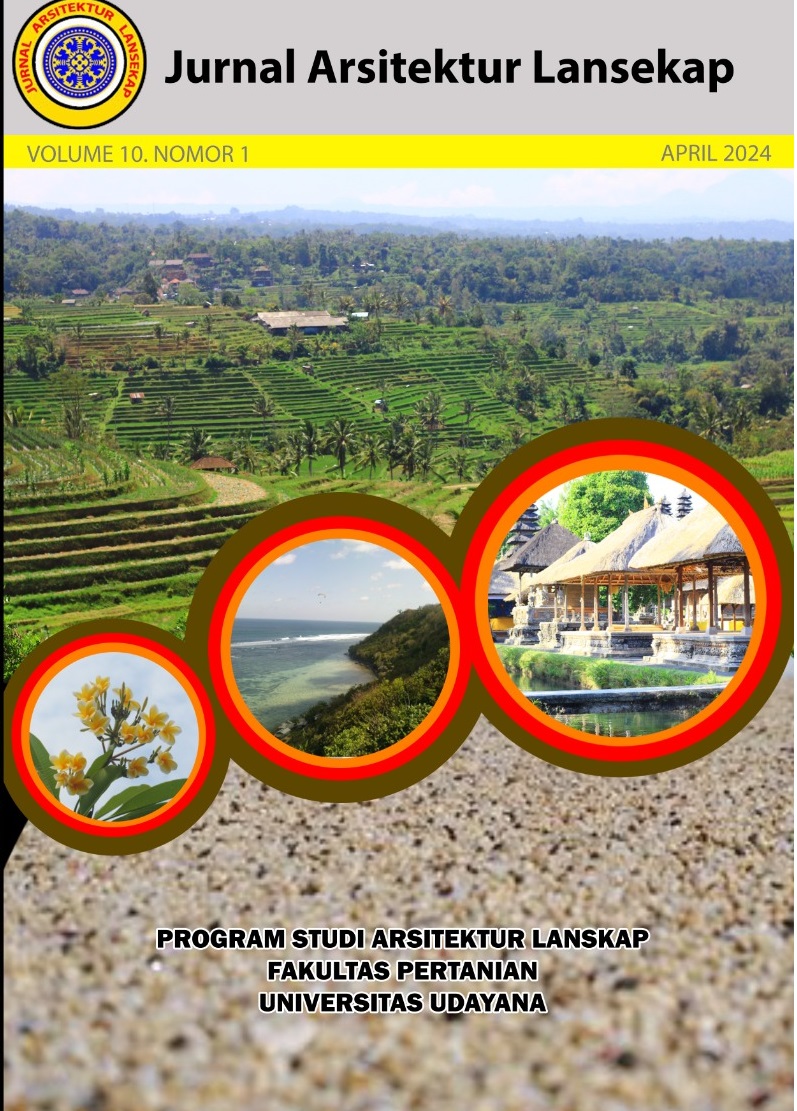Redesain ekologis Kawasan Wisata Danau Sanggu Kabupaten Barito Selatan berbasis konsep waterfront
Abstract
Sanggu Lake Tourism Area, located in South Barito Regency, Central Kalimantan, plays an important role in providing green open space for recreational and relaxation activities. The lack of management and changes in building orientation reduce the quality of the site and pose threats to environmental damage. Therefore it is necessary to redesign the waterfront area with an ecological approach to reduce environmental impact. The purpose of this research is to identify site character, analyze the potential and constraints on the site, to develop an ecological design concept, and to ecologically design the Sanggu Lake Tourism Area based on the waterfront concept. The stages of the research include the process of preparation, inventory, analysis and synthesis, and design. Collecting data through surveys, literature studies, interviews, and questionnaires. The basic concept of the research is "Ranu Welum" or Water of Life which is revealed to be 3 basic values, namely socio-cultural center, ecological park, and recreational waterfront. The design concept is taken from the typical Dayak motif, namely "Batang Garing" or the Tree of Life and implemented in spatial patterns, circulation, and vegetation. Ecological design is applied by implementing ecological principles based on community preferences. The results of the study are area redesign consisting of reception zones, tourist zones I, tourist zones II, relaxation zones, play zones, exercise zones, and service zones.
Downloads
References
Bastiyani, A.H. & Safitri, I. (2013). Arahan pengembangan pariwisata di Kecamatan Dusun Selatan, Kabupaten Barito Selatan Provinsi Kalimantan Tengah. Jurnal Perencanaan Wilayah dan Kota, 13 (2): 1-12. https://doi.org/10.29313/jpwk.v13i2.268.
Booth, N.K. (1983). Basic Elements of Landscape Architectural Design. Elsevier. https://books.google.co.id/books/about/Basic_Elements_of_Landscape_Architectura.html?id=7a0QAAA AQBAJ&redir_esc=y
Hill, W.F. 1995. Landscape Handbook For The Tropics. Garden Art Press.
Keyvanfar, A., Shafaghat, A., Mohamad, S. , Abdullahi, M.M., Ahmad, H., Derus, N.H.M., Khorami, M. (2018). A sustainable historic waterfront revitalization decision support tool for attracting tourists. Sustainable, 10 (215): 1-23. https://doi.org/10.3390/su10020215.
Kurniawaty, P., Gunawan, A., Surjokusumo, S. (2012). Kajian konsep desain taman dan rumah tinggal hemat energi. J Lansk Indones, 4(1): 1-8. https://doi.org/10.29244/jli.2012.4.1.%25p.
Laurie, M. 1990. Pengantar Kepada Arsitektur Pertamanan. Jakarta: Intermata.
Minarni, Prasetyaningrum, E., Hermawan, C. (2020). Pengembangan wisata alam, sejarah dan budaya Kalimantan Tengah memanfaatkan teknologi augmented reality. Jurnal IKRA-ITH Teknologi, 4(3): 40-48.
Nieuwolt S. 1977. Tropical Climatology. John Wiley & Sons. https://books.google.co.id/books/about/Tropical_Climatology.html?id=2zdRAAAAMAAJ&redir_esc=y
Nurrohimah, I. (2022). Persepsi dan preferensi masyarakat terhadap tingkat kenyamanan Taman Merdeka Metro sebagai ruang interaksi sosial di masa pandemi covid-19. Jurnal Lanskap Indonesia, 14(1): 8-15. https://doi.org/10.29244/jli.v14i1.37680.
Rangin, R.A. 2016. Kebijakan pengembangan pariwisata di Kalimantan Tengah (studi terhadap pelaksanaan program pembangunan destinasi dan pembangunan pemasaran pariwisata di dinas kebudayaan dan pariwisata Provinsi Kalimantan Tengah). Jurnal Ilmu Sosial, Politik dan Pemerintahan, 5(1): 26-41. https://doi.org/10.37304/jispar.v5i1.390.
Reid, G.W. 1987.Landscape Graphics. WatsonGuptill Publications. https://books.google.co.id/books/about/Landscape_Graphics.html?id=Tf84AQAAIAAJ&redir_esc=y
Sugiyono. (2019). Metode Penelitian Kuantitatif, Kualitatif, dan R&D. Bandung (ID): CV. Alfabeta.
Taryoto, A.H. 2013. Analisis keberadaan dan kemanfaatan situ di Jabodetabek. Jurnal Penyuluhan Perikanan dan Kelautan, 7(1): 63-75. https://doi.org/10.33378/jppik.v7i1.39.
Timur, U.P. (2013). Advances in Landscape Architecture [bibliografi]. Murat O, editor. InTech.
Torre, L. (1989). Waterfront Development. Van Nostrand Reinhold. https://books.google.co.id/books/about/Waterfront_Development.html?id=7LxPAAAAMAAJ&redir_esc=y
VanDerRyn, S. & Cowan, S. (1996). Ecological Design. Island Press. https://books.google.co.id/books/about/Ecological_Design.html?id=7UQfsbumtzUC&redir_esc=y

This work is licensed under a Creative Commons Attribution-ShareAlike 4.0 International License.
An author who publishes in the Jurnal Arsitektur Lansekap (JAL) agrees to the following terms:
- Author retains the copyright and grants the journal the right of first publication of the work simultaneously licensed under the Creative Commons Attribution-ShareAlike 4.0 License that allows others to share the work with an acknowledgement of the work's authorship and initial publication in this journal
- Author is able to enter into separate, additional contractual arrangements for the non-exclusive distribution of the journal's published version of the work (e.g., post it to an institutional repository or publish it in a book) with the acknowledgement of its initial publication in this journal.
- Author is permitted and encouraged to post his/her work online (e.g., in institutional repositories or on their website) prior to and during the submission process, as it can lead to productive exchanges, as well as earlier and greater citation of the published work (See The Effect of Open Access).
Read more about the Creative Commons Attribution-ShareAlike 4.0 Licence here: https://creativecommons.org/licenses/by-sa/4.0/.







